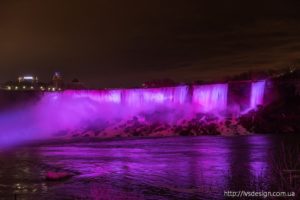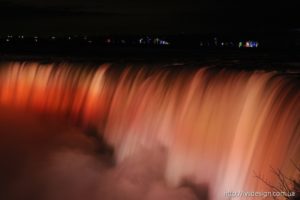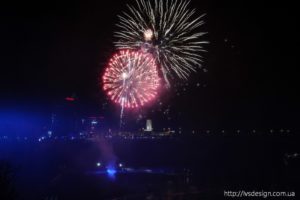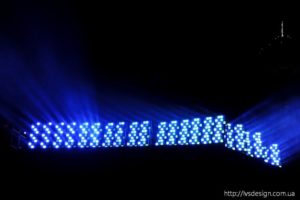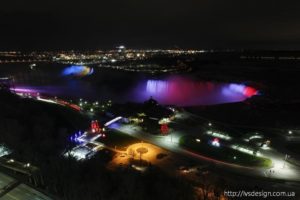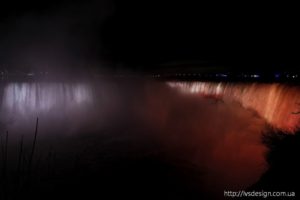The Niagara Falls is a symbolic place where nature itself has united the citizens of the United States and Canada.
From here, Nikola Tesla, began electrifying the world.
There is a mysterious idea that a huge amount of negative ions produced by water creates a feeling of euphoria. Lighted 610 sq.m. of the waterfall unambiguously enhances this feeling.
Lighting a waterfall – jump through history:
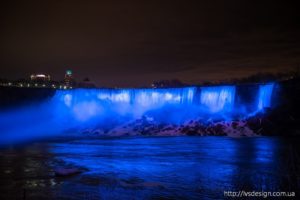
- 1860 – For the first time the Niagara Falls was lit up with 200 Bengal lights. In honor of the arrival of the Prince of Wales..
- 1879 – The waterfall was covered by a carbon-arc lamp for a special visit by the Governor-General of Canada.
- 1901 – The waterfall was lit throughout the week during the Pan American exposition, and then for a month more..
(!) Projectors aimed at the waterfall shine through a painted gelatin film. The construction was held by people who were paid 50 cents a night. Colors were changed manually when workers heard a whistle.
- 1925 – The Lighting Board of the Niagara Falls decides to continuously illuminate the waterfall with coal-arc lamps during the festival of lights.
- 1974 – lamps are replaced by xenon lamps.
- 2014 – Director of Salex (Nick Puipolo), the largest lighting agency in Canada, began to gather a team of lighting designers, engineers, developers, management and installation specialists to implement their lighting design idea.
Who stands behind the waterfall of today?
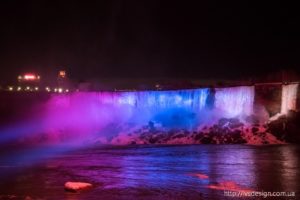
Salex Winners Team:
- Designers Paul Bokin and Alan Mackintosh of Mulvey & Banani Lighting;
- Ed Gesch of Ecco Electric, who designed and made the devices;
- Ron Foley from Scenework, who designed and installed DMX control systems;
- Bobbi Harrell is a Philips Strand Lighting programmer.
- Linus McDonald is a Canadian television lighting designer and a member of the Niagara Falls Lighting Council
10 interesting facts about the lighting of the Niagara Falls
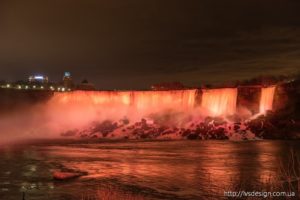
The idea of the project is to provide a system that changes the solid color at any time, and also provides patterns and a color gradient on the water.
1. The lighting system has 21 vertical blocks of color light, providing 350 controlled areas of variable color vertically and horizontally.
2. Boken used a prototype of a 2 º LED device made for Stanley Electric, a manufacturer of headlights.
3. To work the team used AGI32, Google Maps, WYSIWYG, satellite photos, Adobe Photoshop and CAD to calculate the array of devices and colors.
Overcoming a foggy curtain.

4. To overcome the foggy curtain ahead of the waterfall, the team created an additional middle layer of lighting behind the main. So they got the perfect mix of gradients.
5. From the abandoned airport in Welland (Ontario), they simulated and verified the lighting, which repeated the size of the waterfall lighting area.
This place was used to develop individual jumper inside the modules for the perfect mix of colors.Fighting extreme temperatures

6. The waterfall produces heavy suspensions that cause icing. This created additional problems in the work. Salex used an optical glass with a liquid silver oxide, which ensured the heating of the glass and reduced the loss of light flux.
Fastened LED devices, which allowed to focus light, withstand wind loads up to 96 km / h.
Module management
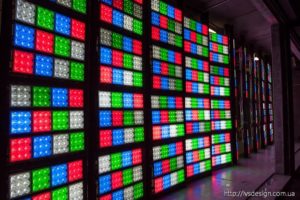
7. To manage the modules the team used:
- 1400 DMX drivers (Moons’, China) have managed enough modules to accommodate color changes.
- For security reasons, they decided not to consider the DMX wireless control.
- Foley has built racks for drivers from regular rails to accommodate audio and video equipment.
- Pathway Connectivity has developed and implemented the DMX distribution. Together with the Department of Parks, the team has stretched thousands of meters of optic-fiber cable to connect.
To create colored conversions

8. To implement the color transitions used
- Touch screens for operators with the ability to switch presets. The Strand Neo console was programmed.
- Harrella had to create profiles for these new devices from scratch, which was complicated by the multitude of colored modules in each device.
- Together with designers, they created 10 presets for each side of the waterfal – northern glow, sunset, sunrise, waves and gradients.
9. Set a mode for special guests who can be invited to an illuminated tower to try to control the lighting in the panel with buttons.
3 locations for lighting
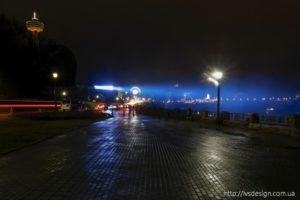
10. Three lighting locations were created
1. For the Canadian side of the waterfall – on the illumination tower, which has long been a place for lighting devices.
2. “Bunker” – an indoor barn near the base of the river, which illuminates the American side of the waterfall.
3. Table Rock Center, which looks at the side of the Canadian waterfall crest.
Idea to the future
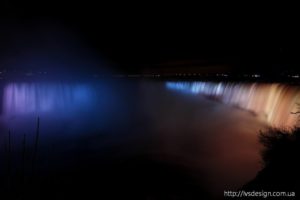
The idea of the project was to make subtle changes and provide an unforgettable tourist photography opportunity.
The system is designed in such a way that future changes and additions could be easily implemented.
Evolution has an exciting opportunities
